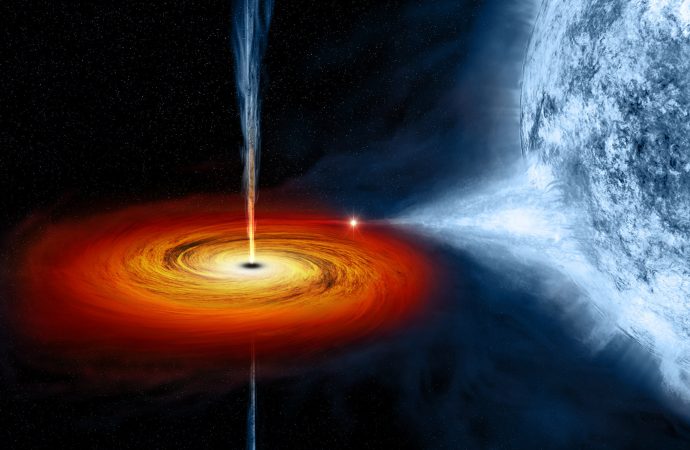Some have cast doubt about the existence of black hole event horizons from which nothing, not even light, can escape the gravitational pull.
But some have cast doubt about the existence of these event horizons. Stephen Hawking, one of the architects of modern black hole theory, wrote a paper in 2014 arguing that event horizons are incompatible with quantum theory. He instead proposed a more benign “apparent horizon,” which only temporarily holds matter and energy.
Another proposed alternative to event horizons is the “hard surface theory,” which suggests that matter within a black hole is destroyed by smashing into a solid surface. Instead of a singularity with no surface area, the black hole is a giant mass with a hard surface, and material being pulled closer — such as a star — would not actually fall into a black hole, but hit this hard surface and be destroyed. If that were the case, the collision should create a large burst of light.
But if event horizons do exist, there wouldn’t be flash of light. Instead, matter would just completely vanish when pulled in.
There are two possible ways to test the event horizon theory versus the hard surface theory. One is direct imaging of a black hole, and astronomers hope to do just that with the Event Horizon Telescope, a powerful array of telescopes around the world that is currently making observations of two supermassive black holes.
But a group of astronomers at the University of Texas at Austin and Harvard University didn’t want to wait for the Event Horizon Telescope data, and used another method to assess this basic principle of black holes. They say that their results, which they describe in a paper published in the journal Monthly Notices of the Royal Astronomical Society, constitute another successful validation of Einstein’s theory.
“Our whole point here is to turn this idea of an event horizon into an experimental science, and find out if event horizons really do exist or not,” said Pawan Kumar, a professor of astrophysics at the University of Texas at Austin, in a statement. “Our motive is not so much to establish that there is a hard surface, but to push the boundary of knowledge and find concrete evidence that, really, there is an event horizon around black holes.”
Kumar, graduate student Wenbin Lu, and Ramesh Narayan, a theorist from the Harvard-Smithsonian Center for Astrophysics, figured out what a telescope would see when a star hit the hard surface of a supermassive object at the center of a nearby galaxy: The star’s gas would envelope the object, shining for months, maybe even years.
When they knew what to look for, the researchers estimated the rate at which stars fall into supermassive black holes to figure out how often this flash of light should be visible.
“We estimated the rate of stars falling onto supermassive black holes,” Lu said. “Nearly every galaxy has one. We only considered the most massive ones, which weigh about 100 million solar masses or more. There are about a million of them within a few billion light-years of Earth.”
The team looked at archival data from the 1.8 meter Pan-STARRS telescope in Hawaii, which had recently completed a three-year project to survey half of the northern hemisphere sky while searching for “transients” — distant bursts of light that glow for a while and then fade. Their goal was to find transients with the expected light signature of a star falling toward a supermassive object and hitting a hard surface.
“Given the rate of stars falling onto black holes and the number density of black holes in the nearby universe, we calculated how many such transients Pan-STARRS should have detected over a period of operation of 3.5 years,” Lu said. “It turns out it should have detected more than 10 of them, if the hard-surface theory is true.”
But they found… nothing. No object displayed the expected light signature that would show evidence of the hard surface theory. The team says this non-finding helps demonstrate that event horizons are real, and that matter completely vanishes when pulled into a black hole.
“Our work implies that some, and perhaps all, black holes have event horizons, and that material really does disappear from the observable universe when pulled into these exotic objects, as we’ve expected for decades,” Narayan said. “General Relativity has passed another critical test.”
Of course, no researcher is satisfied with one test. The team hopes to continue its research with an even larger telescope: the 8.4-meter Large Synoptic Survey Telescope (LSST), which is currently under construction in Chile. Like Pan-STARRS, LSST will make repeated surveys of the sky over time, revealing transients with much greater sensitivity.
But in the meantime, keep an eye out for results from the Event Horizon Telescope later this year.
Source: Seeker

































Leave a Comment
You must be logged in to post a comment.